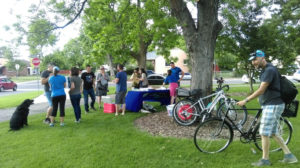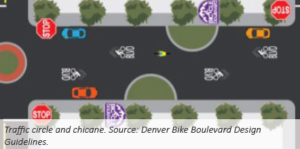Guest Post by Maggie Brown
Read the full Athmar Park Built Environment AssessmentAthmar Park bills itself as “Denver’s best little-known neighborhood” and I have to admit that after seven years living in Denver, I hadn’t heard of it myself until this past summer when I began my internship with WalkDenver. Located west of I-25, bounded by South Federal Boulevard to the west, and West Alameda Avenue and West Mississippi Avenue to the north and south, it is home to one of the most beautiful parks in Denver, several delicious restaurants, and part of the South Platte River trail. And Athmar Park is really starting to make its mark. Thanks to an incredibly dedicated and involved community, the neighborhood association received a grant from Kaiser Permanente last year—an impressive feat considering these types of grants typically go directly to nonprofits—to improve community health through active living.

The grant led to the formation of the Athmar Park Active Living Coalition and one of its main goals is to create an Active Living Plan, with recommendations on how to increase and incentivize walking and bicycling in the neighborhood. One way they are planning to do this is through a community-designed pop-up traffic calming on Tejon Street. If you’d like to get involved in this effort to improve safety in the neighborhood, join the upcoming community meeting that will draw on recommendations from partners and feedback from residents.
Before effective recommendations could be made, a clear understanding of the existing conditions was necessary, and that is where WalkDenver first came in. Over this past summer, I was employed as an intern at WalkDenver and tasked with collecting and analyzing all of the data that relates to pedestrian, bicycle, and transit infrastructure in the neighborhood.
The effort began with WalkDenver’s mobile sidewalk and intersection data collection tool, WALKscope. As an indication of just how engaged and committed the community members already are, I have to point out that the vast majority of the 1,014 data points in Athmar Park had already been collected by volunteers prior to my involvement in the project. But there were still a few gaps, so in June we organized more volunteers, gave them some tamales from a local restaurant, and had them help gather the remaining sidewalk data, as well as collect information regarding the transit stops and bicycle facilities in the neighborhood.

Using all of that information, as well as crash statistics, transit ridership data, vehicle and pedestrian counts, and community input, I developed the Athmar Park Built Environment Assessment Report. What I found was that while Athmar Park has many great assets, it also has some challenges concerning mobility. Below are some of the key takeaways from the final report:

- Nearly all of the neighborhood’s interior sidewalks are three feet or less rollover curbs, which isn’t enough space for most strollers, wheelchairs, or for two people to walk side-by-side.
- South Federal Boulevard and West Alameda Avenue are particularly hazardous for non-motorized users, with the most serious crashes occurring on Federal Blvd. From January 2012 through May 2017, four pedestrians lost their lives and 13 sustained serious injuries in traffic crashes on the short stretch of South Federal Boulevard between West Alameda Avenue and West Mississippi Avenue.
- Bicycle facilities are minimal; shared roadways are the only currently existing type of facility.
- Pedestrian safety is a major issue, with speeding vehicles reported at over half of all intersections, and drivers not obeying traffic controls (like stop signs) at about a third of all intersections.
PEDESTRIANS AND BICYCLE-INVOLVED CRASHES, JANUARY 2012 – MAY 2017

Data source: City and County of Denver
Based on the findings outlined in the report, WalkDenver made the following recommendations to improve Athmar Park’s physical environment for walking and bicycling:
- Add tree lawns, widen sidewalks, and plant trees on residential streets. Install sidewalks and curb ramps where none exist.
- Improve the streetscape and safety on South Federal Boulevard and West Alameda Avenue.
- Encourage transit stop sponsorship.
- Use traffic calming measures to create more a comfortable environment for bicyclists and pedestrians.
- Install traffic calming treatments on streets surrounding Huston Lake Park.
- Improve connectivity and access to key destinations for non-motorized users.



